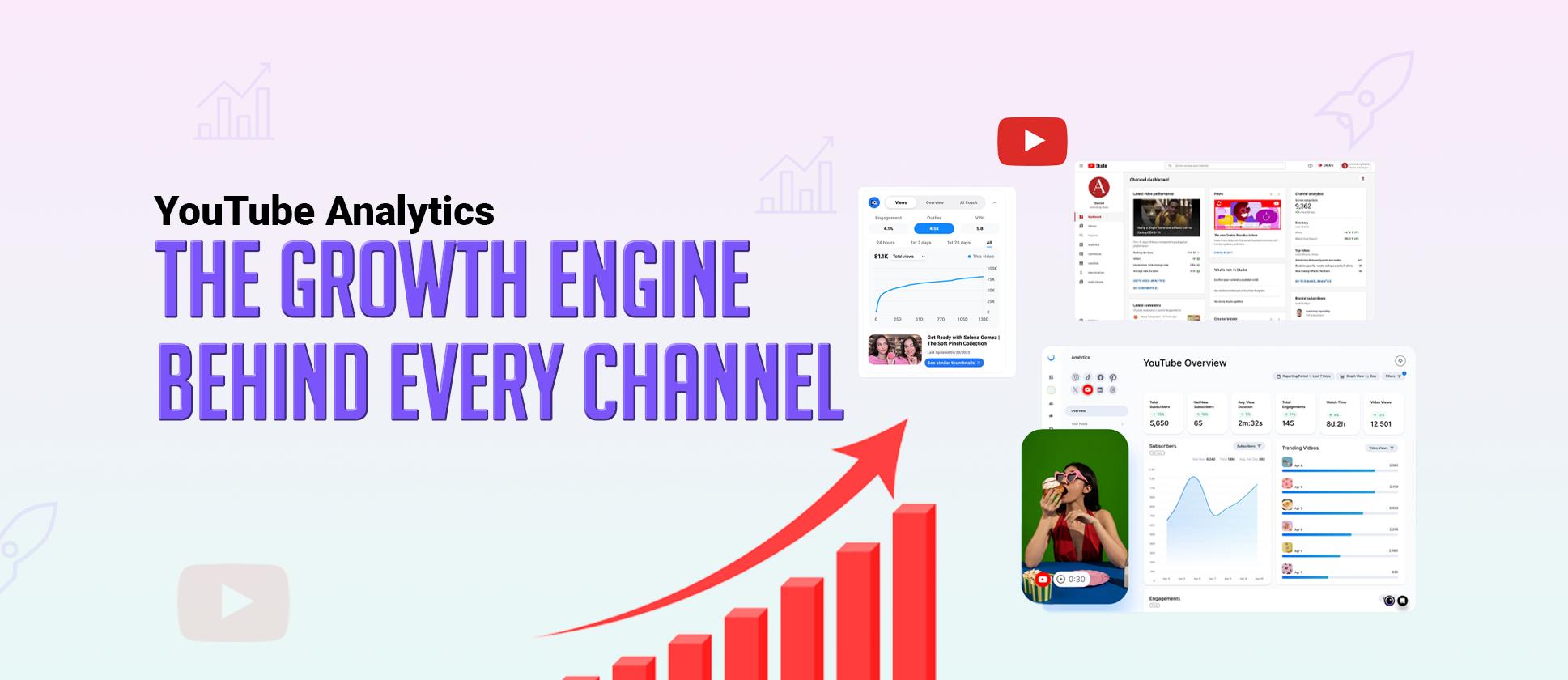Quick Summary
TL;DR: YouTube Analytics is vital for understanding your channel’s performance. Creators should focus on metrics like watch time, average view duration, CTR, audience retention, traffic sources, and subscriber growth, rather than just views. #tldr
- Core Focus:
Metrics → Audience Insights → Competitor Benchmarking → Optimization → Growth
- What Readers Will Learn:
How to access YouTube Analytics → Key metrics that drive growth → How audience insights → Ways to benchmark against competitors → Common mistakes to avoid → Expert tips for using analytics to optimize content
- Main Takeaway:
Get the detailed guide to YouTube Analytics to turn raw numbers into actionable insights. By monitoring the right metrics and understanding the audience, creators and brands can strategically grow their channels.
If you regularly post videos on your YouTube channel but still feel like it’s not growing, you are not alone. Many creators work hard to stay consistent, but the results don’t match the effort. Growth on YouTube is about understanding the numbers behind your content and learning how to use them to guide your next move. The missing piece usually isn’t effort – it’s knowing how to read YouTube Analytics metrics and use them to guide decisions.
According to Soax, over 500 hours of video are uploaded to YouTube every single minute. With so much content out there competing for attention, just looking at “views” can be a bit misleading. A video can grab clicks, but if it doesn’t have good watch time or keep people engaged, it won’t go further with the algorithm. That’s why it’s better to focus on the right metrics instead of just counting views.
Think of these metrics as your channel’s roadmap. They show you which videos actually connect with your audience, where viewers tend to drop off, and what keeps them coming back.
What is YouTube Analytics and Why Does It Matter?
YouTube Analytics is the built-in reporting system inside YouTube Studio that helps creators, brands, and businesses understand how their content is performing. It collects and presents data in the form of analytics metrics, giving you a clear picture of what’s working and where you might need to adjust. Instead of guessing why one video took off while another fell flat, these insights show you the real reasons behind audience behavior.
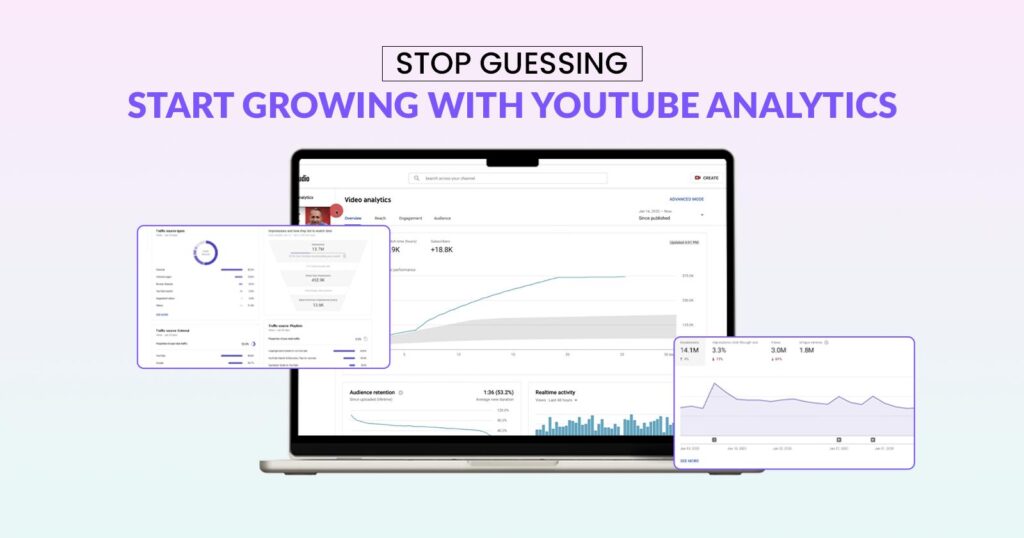
For creators, knowing these numbers is critical because growth on YouTube is rarely about luck. You can also pair these insights with the right video editing tools to polish your content and make it more appealing to the audience you discover through YouTube Analytics. Brands and businesses also rely on the same data to connect content with goals like visibility, conversions, or revenue. When you track the right metrics, you move from creating content blindly to building a strategy based on evidence.
Here are just a few of the key things you can measure inside YouTube Analytics.
- Views – how many people have watched your videos
- Watch Time and Retention – how long viewers stay engaged
- Click-Through Rate (CTR) – how often people click after seeing your thumbnail
- Audience Demographics – check the age, location, and interests of your viewers
- Revenue Reports – an eye on earnings from ads, memberships, and other monetization
- Traffic Sources – where your viewers are finding your videos
Looking at these metrics can really help you make content that your audience actually wants. This way, you can come up with a growth plan based on how they react.
How to Access YouTube Analytics
The good news is that checking your channel’s performance doesn’t require any complicated setup. YouTube Analytics metrics are available to every creator through YouTube Studio, and you can view them on both desktop and mobile. Whether you’re at your desk planning a content calendar or on the go checking how your latest upload is doing, there’s a simple way to stay on top of your numbers.
On Desktop
The easiest way to start is by logging into YouTube Studio from your browser. Once inside, the left-hand menu has an “Analytics” tab. You will start on a dashboard that shows key information like views, watch time, and subscriber changes. To dig deeper, switch to advanced mode. Here, you can filter results by date range, compare how different videos perform, and see detailed sources of traffic.
On Mobile (YouTube Studio App)
For channel management, the YouTube Studio app is the most convenient tool. Just open the app and tap “Analytics” to get a quick overview of your performance, including top videos, audience demographics, and real-time views. It’s especially useful for creators looking to respond to trends or adjust their posting schedules.
Using Third-Party Tools
A lot of creators stick with YouTube Studio, but using third-party tools can give you some extra insights that are pretty helpful. For example, VidIQ and TubeBuddy are popular for keyword research and optimization, while Social Blade helps benchmark against competitors. Publer goes a step further by combining scheduling with analytics, and Google Analytics can tie video traffic back to your website activity.
If you want to go beyond YouTube and see how your videos support bigger business goals, tools like Google Analytics can help connect the dots, similar to how brands track marketing performance across multiple channels.”
Here’s a quick comparison table.
| Tool | Best For | Free/Paid |
|---|---|---|
| YouTube Studio | Native analytics | Free |
| VidIQ | SEO + keyword insights | Free & Paid |
| TubeBuddy | Optimization + competitor tracking | Free & Paid |
| Publer | Scheduling + analytics | Paid |
| Social Blade | Competitor benchmarking | Free & Paid |
The Core YouTube Analytics Metrics You Must Track
To grow your channel, getting views is just the first step. The real benefit is in checking YouTube Analytics. This tool shows how people find, watch, and interact with your videos. The statistics help you see what works, what doesn’t, and how to make better choices in the future. Let’s walk through the key metrics you’ll want to keep an eye on and how to use them to grow your channel.
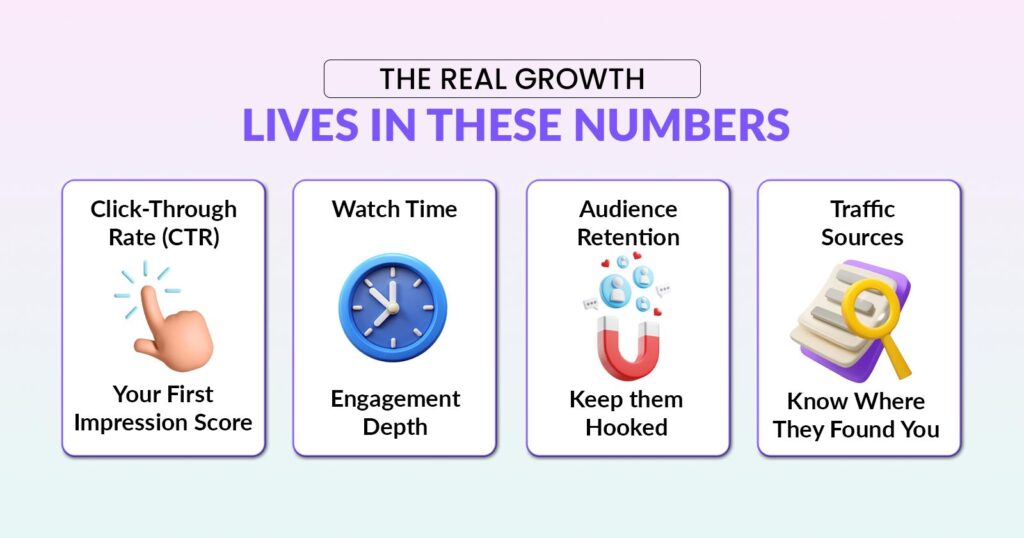
1. Click-Through Rate (CTR)
The most important YouTube analytics metric is CTR. It tells you how often people click on your video after seeing the thumbnail and title. Think of it as your “first impression” score. If your CTR is low, it means people are scrolling past without giving your video a chance.
Why it Matters
The higher your CTR, the more the algorithm will push your video in search results and recommendations.
Best Practices
- Experiment with different thumbnail styles (bold colors, clear text, human faces).
- Write curiosity-driven titles that stay true to the content.
CTR Formula
CTR = (Clicks ÷ Impressions) × 100
Example: If your video shows up 10,000 times and gets 700 clicks, your CTR is 7%.
2. Average View Duration (AVD)
AVD tells you how long people actually stick around once they click. It’s closely tied to retention but focuses on the average across your entire video.
Why it Matters
YouTube wants people to stay on the platform. Videos with higher AVDs send strong signals that your content is engaging.
Example: A 5-minute video where viewers watch 80% (4 minutes) will often outperform a 20-minute video where viewers only stick around for 20% (4 minutes).
3. Watch Time
Watch time is simply the total minutes that people spend watching your videos. Unlike views, this metric shows depth of engagement.
Why it Matters
Videos with higher watch time tend to rank better in search and appear more in suggested videos.
Tips to Increase Watch Time
- Open with a strong hook in the first 10 to 15 seconds.
- Use storytelling to keep viewers curious about what comes next.
- Adjust pacing to avoid long, slow sections.
4. Audience Retention
Audience retention is another one of very important YouTube analytics metrices. It shows how long people stick with your video and where they drop off.
Why it Matters
If many viewers leave in the first 30 seconds, YouTube takes it as a sign that the content didn’t meet expectations.
Inside YouTube Studio, the “Moments for audience retention” report highlights exactly where people rewatched or stopped watching. That feedback is gold for improving your intros and mid-video flow.
5. Traffic Sources
It tells you where your viewers are coming from – search results, suggested videos, browse features, playlists, or even external sites.
Why it Matters
Once you know your strongest traffic source, you can double down on it.
- Search traffic – Focus more on keyword optimization.
- Suggested videos – Create content clusters around successful topics.
- Feature human faces with expressions to make an emotional connection.
For example, if a lot of your external traffic is coming from blogs or educational sites, it’s worth pairing your videos with related written content, like this ChatGPT breakdown guide that explains complex topics in simple terms
6. Subscriber Growth
YouTube shows when and where you gained or lost subscribers. Spikes often mean a particular video hit home, so consider building follow-up content around that format.
Why it Matters
Subscribers are more likely to see future uploads, giving you a built-in audience base.
7. Returning vs. New Viewers
While analyzing your channel’s growth, keeping tabs on this YouTube analytics metric is important. A healthy channel balances both.
- Viewers who return to watch again demonstrate loyalty and are more likely to comment, share, or subscribe.
- New viewers bring fresh growth and discovery.
Tips to Nurture Returners
Create a series, post consistently, and reward engagement by replying to comments.
8. Top Videos Driving Audience Growth
Under the Audience tab in YouTube Studio, you’ll find which videos bring in the most subscribers. These are your “growth drivers.”
Tip: Turn high-performing topics into a series or playlist to keep momentum going.
9. Revenue Metrics (for Monetized Channels)
If your channel is monetized, pay attention to
- Estimated Revenue – total money earned.
- CPM (Cost per Mille) – what advertisers pay per 1,000 views.
- RPM (Revenue per Mille) – your actual earnings per 1,000 views.
- Monetized Playbacks – the number of views with ads.
Tracking these helps you spot which content types are most profitable.
10. Engagement Metrics (Likes, Comments, Shares)
Engagement goes beyond views. Likes, comments, and shares show whether people felt connected enough to respond.
Why it Matters
Strong engagement builds community trust and signals to YouTube that your video deserves more reach.
Quick Tip: Ask viewers to share their thoughts, suggestions, or experiences in the comments. Simple CTAs can make a big difference.
Creators who spark meaningful discussions often see better long-term growth, especially when they share content that explores trending topics such as the role of prompt engineering in content creation.
Audience Insights in YouTube Analytics
It’s one thing to know how many people clicked on your video. It’s one thing to understand who those people are, but it’s another to grasp how they interact with your channel. So, audience insights are of great importance. Instead of guessing, you receive real data indicating who is tuning in, when they are most likely to watch, and what devices they prefer.

Demographics
YouTube helps you understand your audience by showing their age, gender, and location. This information can greatly affect your content strategy. If most of your viewers are from Generation Z, they will likely enjoy videos with quick edits, popular sounds, and short, engaging hooks. Contrarily, if you have a larger Millennial audience, they might prefer videos that delve deeper into tutorials or product reviews.
Location also matters, as knowing your audience’s time zone helps you decide when to post so your content doesn’t get buried. For instance, if your analytics reveal a younger audience, it helps to study how influencers shape consumer behavior, since trends and buying habits often overlap with content preferences.
When Your Viewers Are Online
Timing makes a bigger difference than most people think. YouTube shows you exactly when your viewers are active, and posting just before those windows can give your video a healthy boost. Imagine publishing at noon when your audience is usually online around 7 PM. Chances are, the video won’t get the early engagement it needs to gain momentum. A small shift in your schedule can help you grab more eyeballs from the start.
Devices Used
Finally, pay attention to how your audience is watching. Many creators assume their viewers are on phones, but sometimes a big chunk of views comes from TVs or desktops. If most of your traffic is mobile, make sure text on screen is readable without squinting.
If viewers lean toward TV, consider how your visuals will appear on a larger screen – low-resolution clips or cluttered layouts will stand out more there. Matching your editing style to your audience’s habits makes your videos easier to watch and keeps people coming back.
How to Perform Competitor Benchmarking with YouTube Analytics Tools?
Monitoring your own metrics is crucial, but observing successful competitors can drive faster growth. Competitor benchmarking helps you find content gaps, gain inspiration, and understand your channel’s position in the larger landscape.
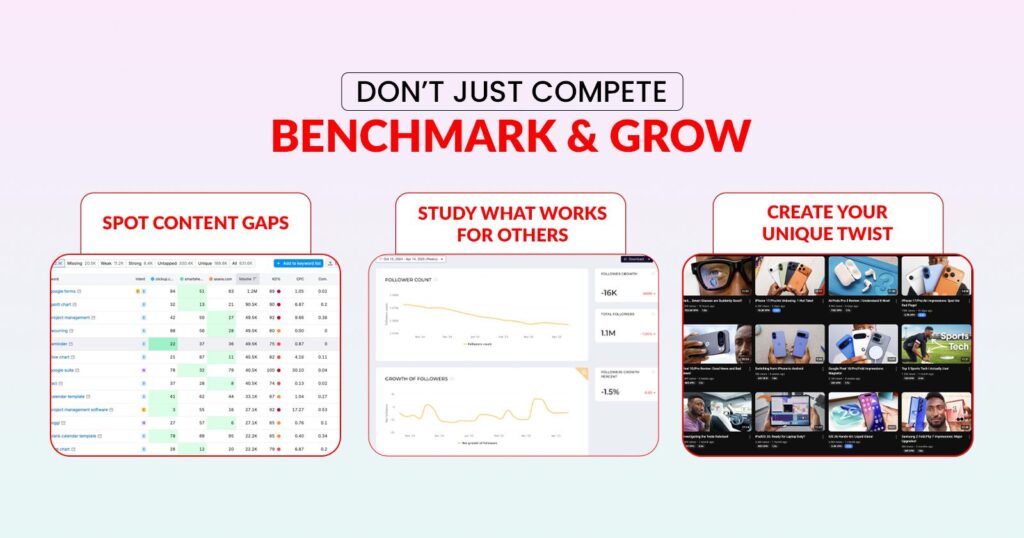
Here are a few tools that can make the process easier.
- VidIQ provides keyword insights and SEO suggestions, revealing why certain competitor videos rank higher.
- TubeBuddy helps with optimization and competitor tracking, so you can see which tags and formats are driving results.
- Social Blade makes it simple to check growth trends, subscriber milestones, and estimated earnings for other creators.
- Tubular Intelligence provides deeper data on cross-platform performance, helping you see what’s going viral beyond YouTube itself.
For example, if you notice a competitor’s short-form series suddenly taking off, that’s a signal. You don’t copy the content, but you can study the format, timing, and delivery style to craft something original that taps into the same audience interest. If you want inspiration for experimenting with formats, exploring short-form content ideas can give you practical ways to adapt trends to your own style.
Which Common Mistakes Creators Make with YouTube Analytics?
YouTube Analytics can feel overwhelming at first, and it’s easy to fall into habits that slow growth instead of driving it forward. Many creators get stuck looking at the wrong numbers, some other video mistakes, or misreading what the data is telling them. Here are a few common pitfalls to avoid.
- Only tracking views instead of retention: Views alone don’t reveal whether people are sticking around. Retention and watch time tell a deeper story about your content’s impact.
- Ignoring traffic source insights: If you don’t know where your viewers are coming from, you can’t lean into the platforms or strategies that work best.
- Over-optimizing thumbnails without fixing content: A flashy thumbnail might get clicks, but it won’t save a video that doesn’t deliver on its promise.
- Uploading blindly without reviewing performance: Without checking what’s working (and what’s not), you risk repeating the same mistakes over and over.
Here’s a quick cheat sheet to flip these mistakes into better habits.
| Mistake | Best Practice |
|---|---|
| Focusing only on views | Track retention + watch time |
| Ignoring traffic sources | Double down on top-performing sources |
| Not testing thumbnails | Use the “Test & Compare” feature |
| No upload schedule | Align with “when viewers are online” |
Expert Tips to Get the Most Out of YouTube Analytics
YouTube Analytics is packed with insights, but the real value comes from how you use them. It’s not about checking numbers every hour; it’s about spotting patterns and turning them into smarter content decisions. To make smarter decisions, it also helps to understand the key marketing metrics worth tracking alongside your YouTube data. Here are a few tips to help you make the most of your data.
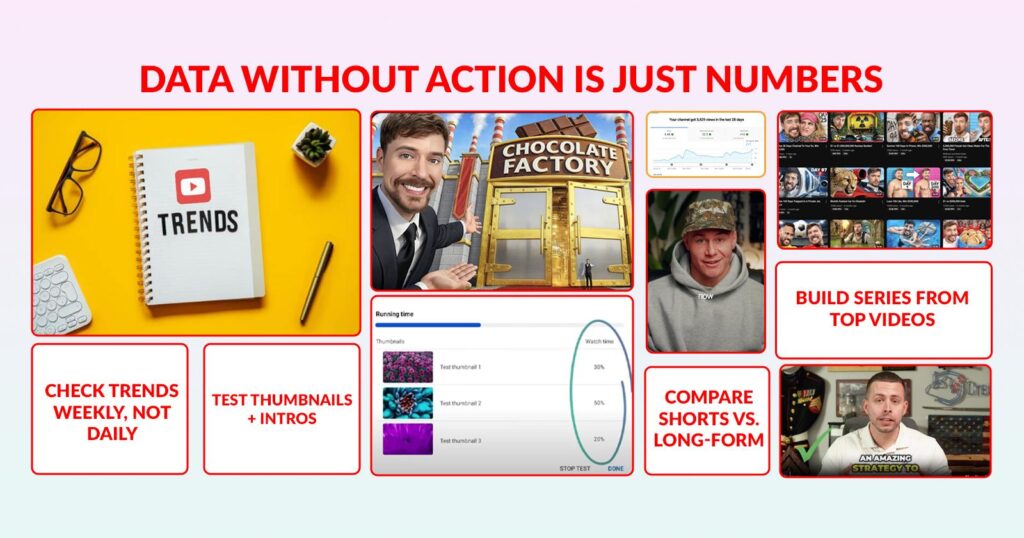
→ Check your numbers weekly, not daily
Daily shifts can feel random, but weekly trends give you a clearer picture of what’s really working.
→ Pay attention to drop-offs and spikes
If people leave within the first 30 seconds, your intro may need tightening. If there’s a spike, note what grabbed attention and repeat it in future videos.
→ Compare formats like Shorts and long-form
Some audiences love quick clips, while others prefer deep dives. Use analytics to see which format earns better watch time.
→ Test thumbnails and intros
A small change in your thumbnail or the way you open a video can have a huge impact on click-through rate and retention.
→ Build a series from your strongest content
When a video takes off, think about creating a follow-up or even a playlist around that theme to keep viewers engaged.
Final Thoughts
YouTube Analytics is more than numbers on a screen. It’s a way to listen to your audience and see what’s really driving growth. Every chart and graph is a clue that helps you create content with purpose instead of guesswork.
Don’t stop at views alone. Pay attention to watch time, retention, and the moments where people stay hooked. These small shifts add up to long-term results. For more ways to strengthen your channel and rank higher on YouTube, take a look at our guide on long-form video SEO in 2026.
Frequently Asked Questions
The key metrics to focus on are watch time, average view duration, click-through rate (CTR), and audience retention. These tell you how engaging your videos are and how the algorithm might treat them.
It shows who is watching your videos, where they found them, how long they stayed, and whether they came back. In short, it tells you what’s working and what isn’t.
Yes, but numbers can sometimes take a day or two to update. What you see inside YouTube Studio is the official data, so it’s the best source for measuring performance.
An impression is counted when your video thumbnail is shown to someone on YouTube, like in search results or recommendations. It doesn’t mean they clicked, just that they saw it.
Unique viewers represent the number of different people watching your content. If the number feels low, it could mean you have a lot of returning viewers or that your content isn’t reaching new audiences yet.
CPM (cost per thousand impressions) varies by niche and location, but most creators see anywhere between $2 and $10. Channels in finance, tech, or business often have higher CPMs than entertainment channels.
No. Returning viewers are counted separately. Unique viewers are about to reach, while returning viewers show loyalty. Tracking both gives you the full picture.
Book a Call Today
- Fixed monthly plans starting at $999
- 24-hour turnaround time (or less) on all short-form edits
- 3-layer quality check system on every video
- No more chasing freelancers or managing editors
- Scale up to 50+ videos/month without hiring in-house
- Content team trained on platform trends, scroll-stopping hooks & storytelling
- Fully managed by professionals – you just upload & approve
- Response time: Under 1 hour (US & GCC time zones)
Cut your production costs, not your standards.

